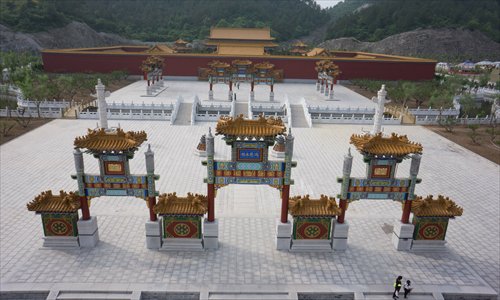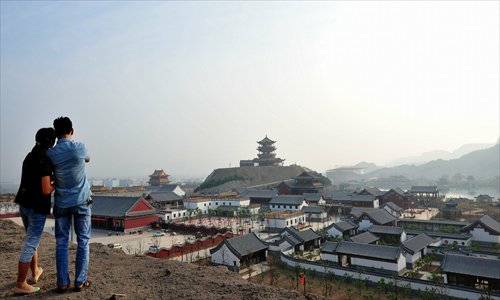Zhejiang businessman attempts to recreate the Old Summer Palace, turn it into theme park

The replica is the same size as the original palace was before its destruction. Photo: CFP

Two people overlook the replica of the Old Summer Palace from a hill. Photo: CFP
The opening of a life-size replica of the Old Summer Palace in Hengdian, Zhejiang Province recently sparked controversy in China. The original palace was destroyed in 1860 when Anglo-French troops looted the palace, creating a national wound. While Xu Wenrong, the man behind the project, says he wants to showcase China's capabilities through the project, while others, including the administrators of the original palace, questioned whether it's possible or necessary to replicate a piece of China's heritage that now only exists in historical records.
For over 150 years, the destruction of the Old Summer Palace, or Yuanmingyuan, has been remembered as a humiliating episode in China's history.
Apart from piles of white rubble, broken Roman columns and a marble pagoda, almost nothing is left of the massive imperial garden that had been enjoyed by six Qing Dynasty (1644-1911) emperors before it was looted and destroyed by Anglo-French forces in 1860 during the Second Opium War.
The park was once regarded as an architectural wonder, the "Garden of Gardens." But today the visitors to Yuanmingyuan Park, a park built on the site of the ruins, can only imagine what it looked like through reading the historical names of each section, such as the Island of Heavenly Light, the Hall of Rectitude and Honor, and the Library of Collected Fragrances. The park has been designated as a site for patriotic education for Chinese students to remember this part of China's past, the so-called "century of humiliation."
Now, over 150 years later, an 80-year-old farmer-turned-businessman in Zhejiang Province is building a life-size replica of the garden in his hometown of Hengdian, hoping to restore how the palace looked in its prime.
"The Old Summer Palace is the pain and the pride of China. I want to prove that the Chinese people have the ability to rebuild it on our own," Xu Wenrong said at a press conference in March.
The new site, located near Hengdian in Dong'an city, sprawls across 413 hectares of land and features artificial lakes, lush gardens and recreated palaces. The main part of the site, the Spring Garden, was opened to public on May 10, while the rest of the project is set to be completed in 2016.
Costing more than 30 billion yuan ($4.83 billion) in total, the project will be used as a theme park and a film set. A day ticket to visit the Spring Garden costs 280 yuan, which is more than 10 times the entry fee to the ruins of the Old Summer Palace in Beijing, which is just 25 yuan.
A businessman's last wish
For Xu, rebuilding the Old Summer Palace was his "last wish in his life." The octogenarian is the founder of the Hengdian Group, which specializes in the manufacturing of pharmaceuticals and rare-earth magnetic materials. In 1995, he founded Hengdian World Studios when a director friend needed a location to build a set for the Chinese historical film The Opium War. Over the next two decades, he transformed farmlands of Hengdian into replicas of Beijing's Forbidden City, and brought scenes from famous ancient Chinese paintings to life. The international media dubbed the studios "Chinawood."
But building another film set was never the major motivation behind his Old Summer Palace project, Xu told the media. Talking about his inspiration for the massive undertaking, Xu repeatedly mentioned French journalist Bernard Brizay's 2003 book The Sack of the Old Summer Palace. In the book, Brizay suggested rebuilding the park as a way to wash away France's crime.
Xu said he was touched by the book and had the idea of rebuilding the park.
"The palace being burned down has always been shameful to the Chinese people. Now even the French people are admitting their mistake, why can't we rebuild the park?" he told media.
Xu expects 40 to 50 million tourists to visit the site in the next five years, and to rake in four to five billion yuan in ticket sales. After 10 years, he projects that the annual number of tourists visiting his version of the splendor of the Qing Dynasty could reach 10 million, and ticket sales may amount to 10 billion yuan.
At the garden's opening ceremony, government officials and historians congratulated Xu on the grand opening of his pet project, saying they hope the park will become a "base for patriotic, artistic and scientific education."
But compared with his other projects, the Old Summer Palace project has faced lots of controversy and adversity. While most of his projects take just a few years to finish, the planning and construction of the Old Summer Palace dragged on for over 10 years, and never failed to draw criticism during every step of its planning.
Complaining curators
The latest controversy came from curators of the Old Summer Palace. In a report by the Xinhua News Agency last month, the administrative department of the Old Summer Palace said that the palace is unique and cannot be replicated. It said it will take legal action against the replica if it infringes upon its intellectual property rights.
This is not the first time that the Old Summer Palace has made such a statement. In 2008, when Xu was preparing to begin building the replica, the administrative department of the old site held a press conference in which they announced their opposition to its construction, citing the same reason.
"We don't agree with the assertion that Hengdian rebuilding the Old Summer Palace is a great endeavor that will help spread traditional Chinese culture, architecture and art of Chinese gardens," Zong Tianliang, a spokesperson of the old palace, said at the conference.
Lawyers, however, said the administrative department of the Old Summer Palace does not own the intellectual rights to the palace, which is a historical complex that no longer exists.
The Old Summer Palace could not be reached for comment or further explanation.
One of its employees, who declined to disclose his name, told the Global Times, "I've been asked not to comment on the issue - neither will anyone else from the Old Summer Palace. It doesn't want to help boost the hype surrounding the replica."
How the replica could recreate an imperial garden that was destroyed 150 years ago was also at the center of debate. While Xu said he had consulted experts and dug out the original blueprints from museums to guide his designs, experts say existing historical records aren't enough to help him accurately build the original garden.
"According to current photos of the new garden, the size, orientation and distance between the buildings are completely different from the historical garden. Even I couldn't recognize what some of the architecture represents. The replica will mislead people and distort their understanding of the original palace," Liu Yang, a researcher specializing in the Old Summer Palace, told the Global Times.
The high entry fee also generated discussion. "It's at most an amusement park. All the talk of arousing patriotic sentiments is nonsense. And who would be willing to pay hundreds of yuan to receive patriotic education?" Liu said.
Some experts took a more relaxed approach. Wang Daocheng, a former professor at the Institute of Qing History at Renmin University of China, said, "The new park doesn't bring in any disadvantages. Plus it will create many local jobs and bring economic gains. I don't see why we should oppose it."
A stalled project
On a recent chilly, rainy Saturday, visitors strolled around the park built on the ruins of Old Summer Palace in northwest Beijing.
A museum, located next to the ruins, gives a fuller account of the history of the Old Summer Palace. The 1860 looting of the palace marked just the beginning of a century of damage to the place. After the Anglo-French soldiers left, the garden suffered from another wave of looting, this time by the ill-disciplined soldiers of the Qing Dynasty and local gangsters, who scavenged whatever was left in the garden and chopped down ancient trees to sell. After the Republic of China was established up until the end of the Cultural Revolution (1966-1976), the garden suffered from further damage. According to a 1980 record, by then, the garden had been occupied by over 2,000 farmers who had filled in its lakes and moved hills in order to grow crops in the garden.
Now keeping a low profile, the Old Summer Palace itself was once at the center of controversy over whether the destroyed architecture on the original site should be rebuilt. In 2000, the State Administration of Cultural Heritage passed a document saying that 10 percent of the area of the site may be used for the restoration of ancient buildings. The project, however, was never carried out due to the massive amount of criticism from those who questioned the meaning of building ersatz architecture on the original site.
In the museum, tourists crammed into a 3D representation of architecture of the ruined garden, marveling at its magnificence and exquisiteness.
"After seeing these ruins, I am really interested to see how the original garden looked, and even though I know the replica in Hengdian is fake and probably of poor quality, I might visit it," Alvin Dong, a 28-year-old tourist, told the Global Times. "After all, it's the best I can get."
Newspaper headline: Regal replica